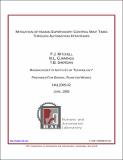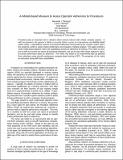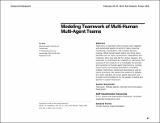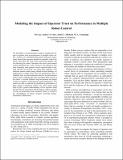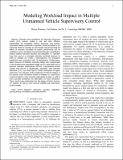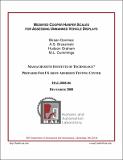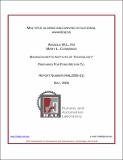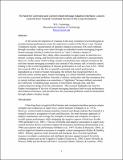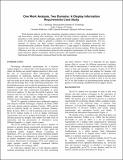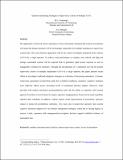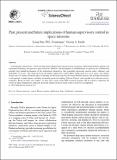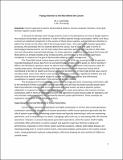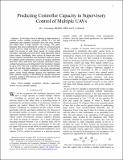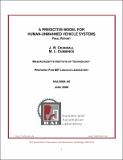Browsing Humans and Automation Laboratory by Title
Now showing items 39-58 of 69
-
Mitigation of Human Supervisory Control Wait Times through Automation Strategies
(MIT Humans and Automation Laboratory, 2005)The application of network centric operations principles to human supervisory control (HSC) domains means that humans are increasingly being asked to manage multiple simultaneous HSC processes. However, increases in the ... -
Mixed-Initiative Strategies for Real-time Scheduling of Multiple Unmanned Vehicles
(American Control Conference, 2012)Advances in autonomy have made it possible to invert the typical operator-to-unmanned vehicle ratio so that a single operator can now control multiple heterogeneous Unmanned Vehicles (UVs). Real-time scheduling and task ... -
A Model-Based Measure to Assess Operator Adherence to Procedure
(HFES, 2012-10)Procedures play an important role in domains where humans interact with critical, complex systems. In such environments, the operator’s ability to correctly follow a given set of procedures can directly impact system safety. ... -
Modeling teamwork of multi-human multi-agent teams
(2013-06)Teamwork is important when humans work together with automated agents to perform tasks requiring monitoring, coordination, and complex decision making. While human-agent teams can bring many benefits such as higher ... -
Modeling the Impact of Operator Trust on Performance in Multiple Robot Control,
(AAAI, 2013-03)We developed a system dynamics model to simulate the impact of operator trust on performance in multiple robot control. Analysis of a simulated urban search and rescue experiment showed that operators decided to manually ... -
Modeling Workload Impact in Multiple Unmanned Vehicle Supervisory Control
(IEEE Systems, Man, and Cybernetics, Part A Systems and Humans, 2010)Discrete event simulations for futuristic unmanned vehicle (UV) systems enable a cost and time effective methodology for evaluating various autonomy and human automation design parameters. Operator mental workload is an ... -
Modified Cooper Harper Scales for Assessing Unmanned Vehicle Displays
(MIT Humans and Automation Laboratory, 2008)In unmanned vehicle (UV) operations, displays are often the only information link between operators and vehicles. It is essential these displays present information clearly and efficiently so that operators can interact ... -
Multiple Alarms and Driving Situational Awareness
(MIT Humans and Automation Laboratory, 2005)There is increasing interest in actively mitigating safety in vehicles beyond that of improving crash worthiness. According to the National Highway Transportation Safety Administration (NHTSA), there are more than 40,000 ... -
The Need for Command and Control Instant Message Adaptive Interfaces: Lessons Learned from Tactical Tomahawk Human-in-the-Loop Simulations
(CyberPsychology and Behavior, 2004)In the recent development of a human-in-the-loop simulation test bed designed to examine human performance issues for supervisory control of the Navy’s new Tactical Tomahawk missile, measurements of operator situation ... -
One Work Analysis, Two Domains: A Display Information Requirements Case Study
(HFES, 2012)d observations, among other techniques. Given the time and resources required, we examine how to generalize a work domain analysis technique, namely the hybrid Cognitive Task Analysis (hCTA) method across two domains in ... -
Operator Choice Modeling for UAV Visual Search Tasks
(IEEE Transactions, 2012-09)Unmanned aerial vehicles (UAVs) provide unprecedented access to imagery of possible ground targets of interest in real time. The availability of this imagery is expected to increase with envisaged future missions of one ... -
Operator Objective Function Guidance for a Real-time Unmanned Vehicle Scheduling Algorithm
(AIAA Journal of Aerospace Computing, 2012-12)Advances in autonomy have made it possible to invert the typical operator-to-unmanned-vehicle ratio so that asingle operator can now control multiple heterogeneous unmanned vehicles. Algorithms used in unmanned-vehicle ... -
Operator Performance in Long Duration Control Operations: Switching from Low to High Task Load
(HFES, 2012-10)Long duration, low task load environments are typical for nuclear power plant control rooms, where operators, after hours of operating under a low task load situation, may have to shift to a high task load situation. The ... -
Operator Scheduling Strategies in Supervisory Control of Multiple UAVs
(Aerospace Science and Technology, 2007)The application of network centric operations to time-constrained command and control environments will mean that human operators will be increasingly responsible for multiple simultaneous supervisory control tasks. One ... -
Partitioning Complexity in Air Traffic Management Task
(International Journal of Aviation Psychology, 2006)Cognitive complexity is a term that appears frequently in air traffic control (ATC) research literature, yet there is little principled investigation of the potential sources of cognitive complexity. Three distinctly ... -
Past, Present And Future Implications Of Human Supervisory Control In Space Missions
(Acta Astronautica, 2008)Achieving the United States’ Vision for future Space Exploration will necessitate far greater collaboration between humans and automated technology than previous space initiatives. However, the development of methodologies ... -
Paying Attention to the Man behind the Curtain
(IEEE, 2011-03)In the push to develop smart energy systems, designers have increasingly focused on systems that measure and predict user behavior to effect optimal energy consumption. While such focus is an important component in these ... -
Predicting Controller Capacity in Remote Supervision of Multiple Unmanned Vehicles
(IEEE, 2008)In the future vision of allowing a single operator to remotely control multiple unmanned vehicles, it is not well understood what cognitive constraints limit how many vehicles and related tasks a single operator can manage. ... -
A Predictive Model for Human-Unmanned Vehicle Systems : Final Report
(MIT Humans and Automation Laboratory, 2008)Advances in automation are making it possible for a single operator to control multiple unmanned vehicles (UVs). This capability is desirable in order to reduce the operational costs of human-UV systems (HUVS), extend ... -
Predictive models of human supervisory control behavioral patterns using hidden semi-Markov models
(Engineering Applications of Artificial Intelligence, 2011)Behavioral models of human operators engaged in complex,time-critical high-risk domains, such as those typical in Human Supervisory Control (HSC) settings, are of great value because of the high cost of operator failure. ...

